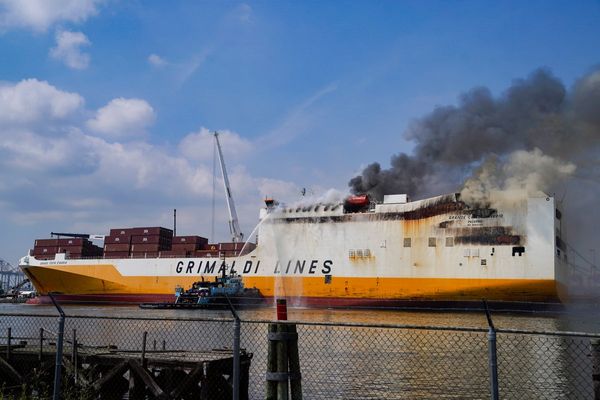It was early July when the waters of the Beaufort Sea crept, then rushed, over the gravel spit of a remote Arctic island. For hours, the narrow strip of land, extending like the tail of a comma into the waters, gradually disappeared into the ocean.
When Canadian scientists on Qikiqtaruk (also known as Herschel Island), off the coast of Canada’s Yukon territory, surveyed the deluge, they saw a grimly comical scene unfold.
Staff from the Yukon government, slogging through the water, were rushing to move historic buildings before they could slide into the ocean. It was not the first time water had enveloped old whaling buildings, and despite the team’s efforts to prevent a sliver of history from being reclaimed by nature, it would not be the last.
Still, with the building perched on wood cribbing and with the aid of a strong cable, they were able, over a period of days, to move it 8 metres (26ft) inland.
“We bought ourselves some time,” says Stephan Biedermann, a conservation carpenter with the government who, for two weeks every year, scrambles with his team to temper the effects of flooding on the buildings. “But these are just short-term solutions. Until we have an idea of what something permanent might look like, we’ll just keep racing to react to these floods.”
Tempestuous weather has long been a staple of life for rangers and researchers working on the remote Arctic isle. But the relentless march of ocean waters inland has raised thorny questions about how to preserve vulnerable elements of Qikiqtaruk’s Arctic heritage.
“There is a stress you feel in the work, knowing there is a growing sense of urgency. But you know the urgency comes from the fact these places are meaningful to so many people, and so the work has value,” says Biedermann.
When Richard Gordon was young, his family made the multi-day trek to Qikiqtaruk from Aklavik in a small boat. He spent summers fishing, camping and running through the remains of weather-beaten buildings.
In August 2023, thawing tundra over permafrost on Qikiqtaruk caused a landslide of thousands of square metres of topsoil. Such events are reshaping the landscape. Photograph: Cameron Eckert
Gordon has spent the past two decades as the lead ranger for Herschel Island-Qikiqtaruk territorial park, a witness to the landslides, permafrost thaw and floods – the ravages of the climate emergency degrading the vulnerable island.
“With the floods getting worse, all the talk is about the plans for the historic buildings. Where will they go? What should we do?” he says.
“But there is less talk about the heritage sites of the island, the places important to the Inuvialuit. There has been no decision on that. Instead, the focus is what do we do with these buildings brought in by newcomers.”
The island of Qikiqtaruk, a short distance off the Yukon coast in northern Canada, has no trees on the smooth rolling hills that, in a number of places, morph quickly into ragged cliffs and steep canyons.
For more than 1,000 years, Qikiqtaruk has been a prized hunting, fishing and camping ground for the Inuvialuit. It occupies an important space in their oral history – and its protected status as Herschel Island-Qikiqtaruk territorial park reflects a hard-won fight to preserve it from outside influence and destruction.
In the late 1800s, the island’s sheltered waters, an abundance of whales in the region and an insatiable appetite for oils and baleen prompted a frenzy of whaling in the north. American and European crews built nearly a dozen wooden buildings along a low-lying portion of Pauline Cove to support nearly 1,500 whalers overwintering on their ships.
Richard Gordon, an Indigenous park ranger on Qikiqtaruk. When he was a child, his family would go to the island to fish and hunt. Photograph: Leyland Cecco/ the Guardian
The remnants of both histories remain scattered on parts of the island. The wooden floor of one building, the Blubber House, is etched with the deep cuts from crews shearing fat from bowhead whales. The Community House is believed to be the oldest wooden-framed building standing in the Yukon. Grave markers of whalers who died a long way from home protrude in a haphazard row in the fields of willows.
With no historic written language and a pragmatic and deft way of using the land, the legacy of the Inuvialuit physical presence can easily be missed. Their sod houses, or igluryuaq, once had cooking hearths and sleeping benches and were hollowed out of the land. What remains of these structures, some of which date back to 1200, appear now as bow-shaped impressions on the land crowned with tundra flowers and grasses.
But within the oral history of the Inuvialuit is a deep catalogue of human expertise on how to thrive in the region – including on Qikiqtaruk. For a people whose language and life is braided into the lands and waters, to lose one begets a fraying of the other.
“If anything happens to one building, they can easily replace it,” says Gordon. “But you can’t replace a culture and a history. If you let those die out, they’re next to impossible to bring back.”
In an effort to underscore the scope of the crisis, researchers have found new ways to bring people – virtually – to the frontlines.
On an early August afternoon, Micah Eckert slogs through the mud of thawed permafrost. He scans the area for higher ground, gingerly leapfrogging the gloopy substance to set up a virtual-reality camera.
Ciara Norton, a Team Shrub researcher, touches the exposed permafrost. When this thaws, it can no longer support the soil above and a landslide, known as a thaw slump, ensues. Photograph: Isla Myers-Smith
Recording a 360-degree vignette of life on the island, Team Shrub – researchers at the University of British Columbia – are working to preserve what they can of a landscape existing on borrowed time. The Qikiqtaruk: Arctic at Risk project aims to show an island teetering on the verge of profound ecological upheaval, hastened by a changing climate.
“The Arctic is warming four times faster than the rest of the world, and it’s making flooding worse, lengthening the ice free season,” says Eckert, a graduate student studying flood mechanics. “Every time we get a flood, which happens more because the coastline is exposed, it is washing away sandy parts of the island, making those same areas more susceptible to the next flood.”
The areas include the island’s only airstrip and the collection of whaling buildings used to host research teams from Canada and Europe. Last summer, there were 19 floods during the summer research season, including 11 consecutive days in August, which Team Shrub captured using virtual reality. Half the buildings are sitting on wood cribbing, with others occasionally inundated with sea water.
“Polar heritage sites are among the most at risk on the planet,” says Peter Dawson, head of the anthropology and archaeology departments at the University of Calgary. “It feels like it’s a crime to let these places disappear without making an effort to save them. We can’t stop climate change, but can preserve as best we can the history of the region.”
With uncertainty looming over the future of the settlement, Dawson, working alongside the Inuvialuit and computer scientists, has spent the past few years creating a meticulous digital archive of the island’s human structures. Each building is reconstructed using millions of laser data points – known as a point cloud – ensuring the structures live on in perpetuity online, outlasting their real-world counterparts.
For the team, the work is particularly important because it gives Inuvialuit residents of Aklavik – the closest community to the island – a chance to revisit the place. Many have strong ties to Qikiqtaruk, either from their youth or through stories from elders. Using the data points, the team has printed out 3D models of the island and its structures.
Pauline Cove and Simpson Point, where a whaling station sprang up in the late 19th century. The sheltered waters and plentiful whales in the region drew nearly 1,500 Americans and Europeans to overwinter there. Photograph: Leyland Cecco/the Guardian
“You can bring these into a classroom. You can show these models to an 85-year-old person who used to live there, and bring them back to the place,” says Dawson. “They can hold it in their hands. It does what sketches or photographs can’t.”
Self-described as “technicians of remembrance”, the team treads carefully, acknowledging the past injustices committed against the Inuvialuit, and all Indigenous peoples in Canada, in the name of “preservation”.
For decades, outsiders pillaged and plundered First Nations’ homes and villages across what is now Canada. Their art, lives and culture were coveted by outsiders and stolen under the guise of conservation.
When staying on the island, Team Shrub lives together in Signals House, which is dedicated to housing researchers. Photograph: Ciara Norton
In 1957, a federally appointed “Indian agent” requested that 12 cedar totem poles, including two mortuary poles, be removed from a site on Haida Gwaii to be “properly preserved for posterity” in museums rather than on the land where the carvers intended.
“Communities have been dealing with loss for more than a century. First it was the ethnographic surveys, acting out of a ‘fear’ that people’s cultures would die out,” says Dawson. “Now, we have climate change.
“The land and the history is disappearing into the sea and so we’re trying to act before it disappears. But we need to ensure the community is centred in this, that knowledge is returned to them.”
Those involved in the efforts also recognise, despite the archive, the limits of such work on a place defined by the lapping ocean waters, lush vegetation and myriad species that make the island home.
“We’re in a fight against time and need to act urgently,” says Dawson. “But if we manage to digitally preserve these spaces, do we need to preserve the real version? Does this make our obligation even greater to preserve and protect the original if we still can?”







